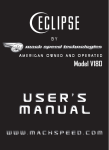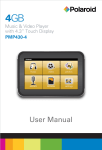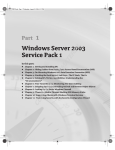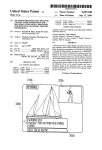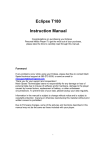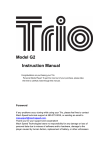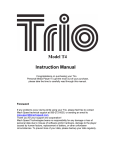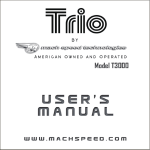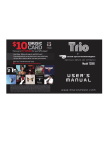Download Mach Trio T4300HD Instruction manual
Transcript
T4300HD Instruction Manual Congratulations on purchasing your Trio Personal Media Player! To get the most out of your purchase, please take the time to carefully read through this manual. Foreword If any problems occur during while using your Trio, please feel free to contact Mach Speed technical support at 580-272-0035, or sending an email to [email protected]. Thank you for your support and cooperation! Mach Speed Technologies bears no responsibility for any damage or loss of personal data due to misuse of software and/or hardware, damage to the player caused by human factors, replacement of battery, or other unforeseen circumstances. To prevent loss of your data, please backup your data regularly. Information in the manual is subject to change without notice and is subject to copyright protection. Copying or otherwise reproducing this material without prior written consent is prohibited. Due to Firmware changes, some of the pictures and functions described in this manual may not be the same as are included with your player. Note: ●The playback times listed refer to the maximum playback times possible, using the best power savings. The actual playback time may differ as adjustments to screen brightness; power savings modes, volume, etc are made. ●There are many brands of Micro SD cards in market, using different quality and speed standards. Therefore, we are unable to guarantee that our product will be compatible with all types or brands of Micro SD cards, but will be compatible with those Micro SD cards with mainstream specifications in the market, and we will constantly strive to provide the largest selection of cards possible. ● As parameters such as formats, bitrate, codecs, framerates, and resolutions differ, the player will not be compatible with all listed files. If you are experiencing issues playing your files on this player, we recommend using a supported conversion tool to reconvert your file to the specifications of the device. Caution Modifications not approved by the party responsible for compliance could void the user’s authority to operate the equipment. NOTE- This equipment has been tested and found to comply with the limits for Class B Digital device, pursuant to part 15 of the FCC rules. These limits are designed to provide reasonable protection against harmful interference in a residential installation. This equipment generate, uses and can radiate radio frequency energy and, if not installed and used in accordance with the instructions, may cause harmful interference to radio or telephone reception, which can be determined by turning the equipment off and on, the user in encouraged to try to correct the interference by one or more of the following measures: Reorient or relocate the receiving antenna. Increase the separation between the equipment and the receiver Connect the equipment to an outlet on a circuit different from that to which the receiver is connected. Consult the dealer or an experienced radio/TV technician for help. Caution • • • • • • • Do not use the player in exceptionally cold or hot, dusty, damp or dry environments. Do not drop, strike, or throw your player. Physical damage to your player will void ALL warranties. Please charge your battery when: o Battery power icon shows an empty icon; o The system automatically shuts down and the power is soon off when you switch on the unit once again; o There is no response if you operate on any key Please always follow the correct disconnect procedures for your operating system. Do not disconnect power abruptly when the player is being formatted or in the process of uploading or downloading files. Otherwise it may lead to file corruption, firmware failure, and even hardware damage. We are not liable for any loss of data stored on this device. Please do not dismantle this player. Any disassembly not done by an authorized technician will void ALL warranties This product and manual are change without subject to notice. Features • • • • • • • • Touch Screen Operating system for ease of use 720P HD Display Supports the following audio formats: MP3, WMA (non encrypted), APE, and FLAC Supports the following video formats: RM, RMVB, AVI, VOB, WMV (non encrypted), ASF, and FLV Supports the following image formats: JPG, GIF, BMP, and PNG Supports eBooks and text files in TXT format Built in Micro SDHC card slot to expand your memory Supports IR remote control Basic Operations Powering ON To power your player on, slide the power switch to the down position and hold it there for 5 seconds or until the Trio Logo is displayed. Powering OFF To power the player off, slide the power switch to the down position and hold it there for 5 seconds or until the Trio Logo is displayed. Once the device has powered off, slide the power switch to the up position until it locks in place. Please note that if you simply slide the switch to the up position to power off, the player will not save any settings changes you have made. Charging the player To charge your player, simply connect it to a powered USB port, or external AC adapter. If you choose to use a third party adapter, ensure that it has 5V and 1000mA output. When connected to a computer you will see the connection screen shown below. This shows that there is both a data and power connection to the player. You may load or remove files from the player while it is charging. When connected to an AC wall adapter, you will see an image of the battery charging, filling up over and over again. You can use the player while it charges by briefly sliding the power switch to the down position. We recommend charging the player for 8 hours for the initial two charges. Subsequent charges should only take 3-5 hours. Inserting and removing the Micro SD card Inserting: Ensure that the player is powered off, and disconnected from the computer. Hold the Micro SD card face up (side with words aligned in the opposite direction of the display screen), and slide the card into the socket on the player, slightly past flush. When you hear the card click into place, you can access the card. Removing: Ensure that the player is powered off, and push the SD card just past flush. When you hear the click, release pressure, and the card will slide out. Caution: Please ensure that the power is off when you connect or disconnect your SD card, or damage may occur to the player or your card. Loading files Using Windows Media Player (Note: you must use Windows Media Player 10 or later to use this feature.) (Note: this player does not support DRM encrypted audio or video files, such as those downloaded from the Windows Media Player “Overdrive” download service.) 1. Open Windows Media Player, enter the sync tab and connect the player to a working USB port. Windows Media player will prompt you with a setup screen asking you to name the MP3 player. 2. Once you have named your MP3 player, select Finish, and your Windows Media Player will open to the Sync tab. 3. Drag your music to the sync list (on the right of the screen) from the list on the left. Once you have selected the music you wish to add to the player, press Start Sync. 4. Windows Media player will load the songs on to your player. 5. Once all the songs you have added are synced to the unit, and Windows Media Player says that is safe to disconnect your MP3 player, disconnect the device. COPY AND PASTE Note- This alternate method is used to load videos, pictures, and ebook files as well as audio files 1. Connect the MP3 player to a working USB port. 2. When the unit is connected to your computer, it will create a gray and green icon in the system tray (lower right hand corner of your desktop). The icon will be called safely remove hardware. 3. Go to the “My Computer” section of your computer. In there you will find a section called “devices with removable storage” 4. Locate the drive created by the unit, generally just called Removable Disk, with a letter in Parenthesis. Drive letters vary depending on your system configuration. 5. Open the drive by either double left clicking on the drive itself, or by right clicking to open the option menu then left click on the desired drive. 6. Locate the music stored on your computer. Generally this is stored in the “My Music” folder of your computer. NOTE: if you are unable to locate the music on your computer, click on start, search, files and folders, then search for “*.MP3, *.WMA”. 7. Once you have located the song files, you can right click on the song itself, and select “copy”. Open the removable disk drive, right click on in the empty space, and select Paste. This will transfer the song on to your player. 8. Repeat step 7 for as many songs as you want to copy on to the unit. NOTE: MAC Computers When connected to your MAC computer, the device will act as a removable drive. Simply drag your files to the device. Main Menu The main menu of the player lets you access the other modes of the player. On the default screen you will have Video, Music, eBook, Photo, and Record options. Place your finger on an icon and slide it to the left to scroll to Radio, Explorer, Calendar, Time Zone, Stopwatch, Calculator, and Settings. Tapping any of these icons will allow you to enter that particular mode. Search In addition, you are able to enter the search feature by tapping the Search Bar in the upper right hand corner of the desktop. Below the search bar is the Time and a button which will allow you to select what you are searching for. MU is music, VID is video, IMA is images, TXT is text files, ALL is to search for anything. In the search window use the keyboard to type out the name of the file you want to open. As you type in the name, options will begin to appear. When you see the item you want, tap it to access the file. Common Icons Some common icons you will see when using the player are listed here. These icons always have the same function, no matter what mode you are in. Home- Tapping this icon will return you to the main menu. Back- Tapping this icon will return you to the previous screen. Volume- This icon may be white or blue, and will display a number after the speaker icon. Tapping this icon will bring up a slider which allows you to adjust your volume. Battery- This icon will display how full the battery is. Purple is good! Back- this is the Back icon used in many system settings modes, and will be located in the upper right hand corner next to the battery icon. Look for this if you cannot see the normal Back icon. Alternate Play-While not an Icon, it is worth noting that in most playback modes (Music Mode, Video Mode, etc) sliding the power button down briefly will alternate between pausing the file and resuming playback. Video Mode Video mode will allow you to view the video files you have saved to your player. • Please note that this player will only support videos in RM, RMVB, AVI, VOB, WMV (non encrypted), ASF, and FLV formats. After selecting Video, you will come to a video selection screen which will display your video files a preview image of the video, and the file duration. Only 6 videos are displayed on the screen at once, if you have more loaded on the player, touch the screen and slide your finger up to scroll the list. To begin playing a file, simply tap that file. Button Explanation Display Mode- This player has a 16:9 screen ratio, and if your video file is the same ratio, pressing this icon will do nothing. If your video file is a different ratio, this will alternate between full screen (video dimensions) and “optimum display” (also by video dimensions) Previous- Tapping this icon will skip to the previous track, and if you press your finger there and hold it, the current video will rewind. Play/Pause- Tapping this icon will alternate between playing and pausing the file. If you pause a file, and then return to the main menu, or press the back button, the player will remember your place in the video. When you return to video mode and that video, you will be prompted to resume playback. Next- Tapping this icon will skip to the next file, and if you press this icon and hold your finger there, the current video will fast forward. More- This will open your video submenu, which is explained below. Video Submenu The Video Submenu will allow you to jump to a point in the video, turn on captions (if available), change the caption language, or skip to a track in the video file (if available) Select Time Play- This option will allow you to jump to a specific time in your video file. The first item represents the hour, the second, minutes. Tap the “+” above the number to increase its value, and the “-“ below it to decrease. Select YES to skip to that point in the file, or NO to cancel. In the example below, the user will skip to 1 hour and 3 minutes into the file if they select YES. Alternatively, you can tap the progress bar on the display screen to jump immediately to that point. Caption- Selecting this option will enable or disable captions or subtitles for the current video file. If you do not have a subtitle file for the video you are watching, this option will be faded out and unselectable. Caption files must be in SRT format, must be named identically to the video file (aside from the extension), and loaded in the same folder as the video file. Caption Language- This option will allow you to select which language the captions display in. If you do not have a subtitle file for the video you are watching, this option will be faded out and unselectable. Caption files must be in SRT format, must be named identically to the video file (aside from the extension), and loaded in the same folder as the video file. Track- Some video files have “track” or “chapter” tags attached, which will allow you to skip to a specific point in the file. If your file does not have these tags, this option will be faded out and unselectable. Music Mode The Music mode is a catch all audio playback mode. This will play any music files, voice recordings, audio samples, and audio books you may load to the player. Several times we will refer to “music” but this will reference to all audio files. • Note- this player will playback files which are in MP3, WMA (non encrypted), APE, and FLAC formats. If your audio files are not in one of these formats, the files will not play. When you enter Music Mode, you will be presented with a music selection screen, which will allow you to select audio files. Only 6 files are displayed on the screen at once, if you have more loaded on the player, touch the screen and slide your finger up to scroll the list. There are several sort modes, which will allow you to find the music you want faster. All Music- this will display all of your music files in alphanumeric by filename. Tap a file to begin playing that file. Artist- This will display your Music by Artist. Tapping an artist will display all songs by that particular artist in alphanumeric order. Tap a file to begin playing that file. Album- This will display your Music by Album. Tapping an album will display all of the songs in that particular album in alphanumeric order. Tap a file to begin playing that file. Genre- This will display your Music files by genre. Tapping a genre will display all of the songs in that particular genre in alphanumeric order. Tap a file to begin playing that file. Play List- You may have noticed while searching for music, that each audio file has a “Plus Sign” to the right of it. If you tap this “Plus Sign” it will add that particular song to your Playlist. When you select this icon, it will display all files loaded in your Playlist. Tap a file to begin playing that file. When in the playlist selection screen, tap the “Minus Sign” to the right of the file name to remove that file from the Playlist. More- Tapping this will bring up the Music Selection Submenu, explained below Music Selection Submenu This submenu will allow you to select voice recordings you have made, view your files in a directory listing, update your Media Library, and resume playback of previous files. Record Files- Displays any audio recordings you have made in Record mode (explained in the Record section of this manual) in alphanumeric order. Dir List- Allows you to select your music files in a standard directory listing. Tap a file to begin playing that file. Update Media Library- Selecting this item will re index all of your audio files, removing any files from your lists which you may have deleted, or add files to your lists which you may have loaded on to the player. As a general rule, anytime that you add or remove a significant amount of audio files from the player, you should update your Media Library. Hold On Play- This player will remember the last three files that you were playing and stopped. Tapping any of these files will begin playing the file at the place you left off. Resume Play- Selecting this will automatically resume playing the last audio file you were listening to, at the place you left off. This option is ideal for audio books. Once you have entered the Music Playback mode, your file should begin playing automatically. This screen will display a visualizer, equalizer mode, bitrate, repeat mode, file name, artist, album, and lyrics (if available). If you have Album art properly loaded, the CD image in the upper right hand corner will change to that album art. EQ- Tapping this icon will cycle between the Equalizer settings Choose from Normal, 3D, MSEQ, Rock, Pop, Classic, Bass, Jazz, and User EQ. your selection will be displayed at the top of the screen, between the visualizer and CD/album art. More- Tapping this icon will open the Music Playback Submenu, described below. Play/Pause- Tapping this icon will alternate between playing and pausing the file. If you pause a file, and then return to the main menu, or press the back button, the player will remember your place in the file. When you return to Music Playback mode and that video, you will be prompted to resume playback. Previous- Tapping this icon will skip to the previous track, and if you press your finger there and hold it, the current track will rewind. Next- Tapping this icon will skip to the next file, and if you press this icon and hold your finger there, the current track will fast forward. A-B- This icon controls you’re a-B Repeat Function. While a file is playing, tap this icon to set an A point. Allow the file to proceed and tap the icon again. This will set your B point. At this point, the file will play from points A to B over and over again. Tap this icon a third time to exit A-B Mode. Music Playback Submenu The Music Playback Submenu will allow you to adjust your Repeat Mode, Play Mode, and adjust some equalizer settings. Repeat Mode- This will allow you to adjust your repeat mode. Choose from: • Once- Play a single file one time • Repeat- Play a single file over and over again • All- Play all of the files in this selection one time • All Repeat- Play all of the file in this selection over and over again • Intro- Plays 10 seconds of each of the files in this selection Play Mode- Allows you to alternate between playing your files in order, or shuffle them MSEQ- Select which of the Special equalizer settings to activate; 3D, Bass, or Normal. Please note that after selecting this, you will need to set your Equalizer to MSEQ mode. User EQ Setup-Allows you to set up a customized equalizer setting. Please note that after selecting this, you will need to set your Equalizer to User EQ mode. eBook Mode The eBook mode allows you to view your text, lyric and caption files. You can even listen to your music while reading. • Please note that eBook mode will only access files in TXT, LRC or SRT formats. If your files are not in one of these formats, they will not be recognized. When you enter eBook Mode, you will be presented with a file selection screen, which will allow you to select files. Only 6 files are displayed on the screen at once, if you have more loaded on the player, touch the screen and slide your finger up to scroll the list. If you have loaded your text files within a folder, tap that folder to enter it. Tap a text file to begin displaying that file. To advance the file, touch the screen and slide your finger up. This will scroll the file. Bookmark- This player can save up to 10 bookmarks at one time. Tap this icon to bring up three options: Save Mark- allows you to save your place as one of 10 bookmarks Load Mark- Allows you to load one of 10 saved bookmarks. Delete Mark- Allows you to delete one of 10 saved bookmarks. Auto Scroll- Tapping this icon will begin scrolling your text automatically. Tapping it again will stop the scrolling. More- Tapping this icon will open the eBook Submenu, explained below. Page Jump- Tapping this icon will allow you to jump to a specific page in the file. Set a page number from 00001 to 99999 and select yes to jump to that page. Please note that that if you set the number higher than the number of pages that your file actually contains, it will simply jump to the last page of the file. eBook Submenu The eBook Submenu allows you to change your background color, Font color and size, and set up an auto page turner. Back Color- Set the background color to Blue (default), Green, or Black. Set Color- Set the Font color to White (default), Purple, or Grey Set Font- Set he font size to Small, Medium (default), or Large Flip Time- Set up a function that will automatically flip the pages for you on a timer. Photo Photo Mode will allow you to view your pictures and images. • Please note that this player only supports images in JPG, GIF, BMP, and PNG formats. If your image files are not in one of these formats, it will not be recognized. After selecting the Photo Icon from the main menu, you will be taken to an image selection screen, which displays thumbnails of your image files, and folders which may contain image files. This screen will display 15 image thumbnails or folders. If you have more than 15 available, touch the screen and slide your finger up to scroll the screen. Tap a thumbnail to begin displaying your images. When viewing an image, the image will adjust automatically for optimum display. To move to the next or previous file, touch the middle of the screen and slide your finger to the left or to the right. Rotate Right- this will rotate the current image 90 degrees clockwise. The image will automatically adjust for optimum display. Rotate Left- This will rotate the current image 90 degrees counter clockwise. The image will automatically adjust for optimum display. Start Slideshow- Tapping this icon will begin displaying your images as a slideshow. The slideshow timer is set in the Photo Submenu, explained below. Tapping this icon again will stop the slideshow. Optimize Display- Tapping this icon will restore your image to optimum display. This is generally used after zooming in on an image. Zoom in- Allows you to zoom in on an image. Tapping this image will zoom in an additional 25%, up to a total increase of 100%. When zoomed in, you can view different parts of the image by touching the screen and sliding your finger. More- Opens the Photo Submenu, explained below. Photo Submenu The Photo Submenu allows you to set an image as your desktop background and adjust the timer on the slideshow. Set as desktop- Selecting this item will set the current image as your desktop background. Slide Time- Allows you to set the length of time an image is displayed when in slideshow mode. Options are 2, 3, 5, 10, or 20 seconds. Record The Recorder mode is used to make voice recordings. The Microphone is built into the player, and the Microphone hole is located between the power switch and the HDMI port. This player is designed to record audio up from up to 3 feet away. Any further and audio will be quite faint and hard to understand. Recordings you make can be accessed through the Music Mode, in the Music Selection Submenu. The recording screen will display the name of the file being recorded (VREC001.WAV in the example above) as well as the length of the current recording and the maximum amount of recording time left. Begin Recording- Tap this icon to begin recording. The status above will change from “Ready” to “Recording” and the record counter will start moving. Stop Recording- While recording a file; tap this icon to end the recording. The player will prompt you to save the recorded file. Pause Recording- While recording a file; tap this icon to pause it. The recording status will change to “Paused”. Tap it again to resume recording, or tap the Stop Recording icon to stop and save the recording. FM Radio Your Player comes equipped with an FM receiver which will allow you to listen to local radio stations. Before entering Radio Mode, we recommend inserting your headphones, as they will act as antenna, and greatly increase the reception of the player. This player can save up to thirty stations as presets. Search Control- Tapping this allows you to toggle between search controls and scan for stations. Auto Scan- Automatically scans the available stations and saves any with a strong signal as a preset. This will override any presets you have manually saved. Manual Search- Selecting this will increase or decrease the signal by 0.1MHz when you tap the Next or Previous Icons Preset- Selecting this option will skip from preset station to preset station when you tap the Next or Previous icon. Region Selection- Tapping this icon will allow you to select your region and which stations you can pick up. Save Station- Tap this icon to save the station you are currently listening to as a preset. Once you have tapped this icon, a list of presets comes up. Tap the preset you wish to save under. Skip to Preset- Tap this icon to open the Preset list. Tap one of the presets to skip directly to that channel. Previous- This Icon has multiple functions in Radio Mode. Please see the description of Search Control. Next- This Icon has multiple functions in Radio Mode. Please see the description of Search Control. Begin Recording- This icon is located in the upper right hand corner of the screen, by the volume and time. When you tap this icon, it will immediately enter recording mode and begin recording the FM station you are currently receiving. When in this mode, follow the instructions listed in Recording mode. Explorer The Explorer mode allows you to view and access your files in a standard folder structure, or to delete files. This screen will display only 6 files at a time. If you have more than 6 available, touch the screen and slide your finger up to scroll the screen. Tap the file you wish to access, and it will automatically enter the appropriate mode and begin playing the file. To delete a file, place your finger on a file and hold it there for several seconds. A message will come up asking whether you wish to delete the file or not. Select yes to delete. Calendar This simple calendar allows you to check dates. Tap the or icons to swap between months and the Icon to return to the current date. Your Date and time is set using the System Time option in the Settings. Time Zone The Time Zone option lists the current time (based on the time you have set in the player) of a number of prominent cities throughout the world. Tapping the or icons will swap between different cities and tap the city name to bring up a list of cities which will allow you to select one directly. If there is one city you check regularly, tap the icon to set the current city as your default. Stopwatch You can use the player as a stopwatch to time yourself of your friends. Begin- Tap this icon to begin the stopwatch. While the timer is running, this icon will change to stay “Pause” and tapping it will pause the timer. Clear- Tap this icon to clear the current timer and all previous counts. While the timer is running, this icon will change to say “Count”, and tapping it will save the current time to the first available count. This is useful for timing several items at once, like a footrace. Calculator This player comes equipped with a standard calculator. Tap the icons on the screen to perform your calculations. System Settings The system settings menu allows you to adjust most facets of your player. Whether the desktop picture, screen brightness, system time, or power savings settings, it’s all found here. Remember that in order to save any settings changes you make, when you power off, do so by sliding the power switch to the down position for 5 seconds. Display Settings- Adjust your display settings, including brightness, and the light time. • Light Time- If you are not viewing pictures or watching a video, and do not touch the screen, the player will power the screen off to conserve battery life. This allows you to adjust the length of time (in seconds) that the screen will stay lit when not used. • Brightness- This will allow you to adjust your backlight brightness which will make your screen easier to view. The brighter the screen, the faster the battery will drain however, so we recommend brightness level 5 in bright daylight, and when inside, in more relaxed light, a setting of 2 or 3. System Settings- This setting will allow you to restore the player to default, adjust a touch pad lock, or calibrate the screen. • Restore- Selecting this function will restore all of the settings to default. • Key Lock Time- When the device is idle, this setting will automatically lock the screen. This is good for times when you have the player in your pocket or bag, or if you are running, to prevent you from accidentally changing modes. When locked, you can unlock the keypad by touching the arrow in the middle of the screen and sliding it to the right. • Calibration- if your touch seems to be slightly off when you tap the screen, you can use this function to calibrate the screen. Please note that powering the player off when calibrating will render your touchscreen inoperable, and will void your warranty. Desk Top This allows you to select one of eight images as your desktop. Tap the desktop you want to have. If you don’t like any of them, you can set your own. Instructions for this are listed in the Photo section. Language This will allow you to change the display language. Tap the language you want displayed. System Time This is where you will set your system time, which is referenced by the clock on the player, the timestamps on recordings you make, and Time Zone mode. From Left to Right the options are Year, Month, Day, Hour, and Minute. Tap the “+” above the item to increase the value, and the “-“ below it to decrease. Once you have set your date and time, tap “YES” to save it. Auto Shut Time You can set this option to power the player off when the player is idle (no music playing, not watching a video, etc) in order to conserve battery life. TV Out Setting This is the settings change for the HDMI output on the player. • TV switch- Allows you to manually change your display to HDMI or back to the player’s screen. The default option is Auto Detect, which will automatically switch back and forth when an HDMI connection is detected. • TV Out Mode- This selects which type of HDMI and hz rating to output when connected. Please check with your TV manufacturer to check as to which is best for you • TV Out Screen Size- This selects what size image is output to your television. Please check with your TV manufacturer to check as to which is best for you Please note that when you are connected by HDMI, you will use the included remote control to control the player. Key Volume You can set this to make a noise whenever you tap an icon on the screen. System Information Displays relevant system information including the firmware version, and memory. If at any point, you have questions about your player or experience an issue with your player, please feel free to contact our technicians at [email protected] or by phone at 580 272 0035.































